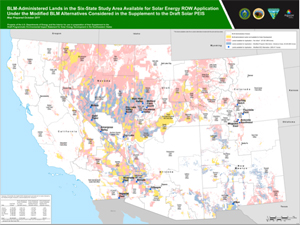Conservation, solar groups support DOI’s proposed Solar Energy Zones
 During the President’s State of the Union address last week, he mentioned that he was opening up public lands for solar development. He was referring to the Department of the Interior’s proposed 17 Solar Energy Zones on 285,000 acres of public lands in the desert southwest—enough land to power at least 3 million homes.
During the President’s State of the Union address last week, he mentioned that he was opening up public lands for solar development. He was referring to the Department of the Interior’s proposed 17 Solar Energy Zones on 285,000 acres of public lands in the desert southwest—enough land to power at least 3 million homes.
A diverse group of conservation and solar advocacy groups, utilities and solar developers sent a letter to Interior Secretary Ken Salazar in support of the Interior’s work thus far and offered insight into what the next necessary steps should be.
The signatories of the letter dated Jan. 27 included the Natural Resources Defense Council (NRDC), Defenders of Wildlife, The Wilderness Society, Solar Energy Industries Association (SEIA), SunPower Corp., Southern California Edison and other groups.
“We have been working for a while with industry to create a balanced solar program,” said NRDC spokesperson Serena Ingre.
Prior to Salazar’s and the Administration’s development of the Supplemental Draft Programmatic Environmental Impact Statement (SPEIS) for public lands in Arizona, California, Colorado, Nevada, New Mexico and Utah, there wasn’t a means to help develop solar on public lands. In crafting a response to the SPEIS, NRDC collaborated with the industry, utilities, regulators and county board members.
In the letter, the groups wrote that they agreed on a number of things related to the development of solar on public lands.
Firstly, that solar energy development in the right places on public lands is necessary, and secondly, that zones are a land-use-planning tool that can facilitate solar development, especially by clustering projects around transmission, minimizing other infrastructure needs and reducing the footprint of that development.
The zones are proposed lands where solar projects will have less impact on wildlife and lands which have been previously disturbed or have less environmental value than some other publicly managed lands in the region. In exchange for developing projects on these lands, the department proposes a simplified permitting process that eases access to financing and helps them reach construction and completion quicker.
“This is the first that it’s ever been done in our country. We want to make sure any program that they come up with is balanced,” Ingre said.
The signatories want to ensure that the industry can compete with other sources of energy, grow and build clean energy quickly, while protecting landscapes and animals.
The letter suggested the DOI should create a more robust system of zones, focused on identifying sites close to transmission lines with appropriate land resources for utility-scale solar deployment. They also called on the department to finalize the program by the end of fiscal year 2012.



